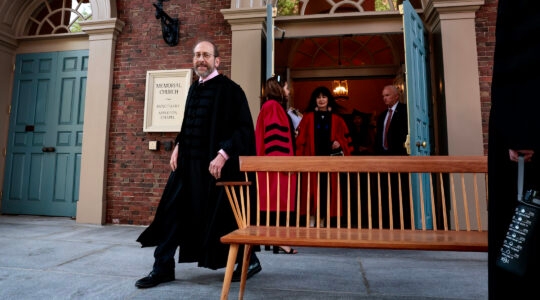When she was arrested earlier this week during a peaceful St. Louis demonstration against police actions in Ferguson, Mo., Hedy Epstein grabbed national attention.
That was partly because, as a 90-year-old white woman, Epstein was not the typical advocate for a young unarmed black man killed by the police. But her Holocaust past — she fled Nazi Germany as a child — arguably played an even bigger role.
Nationwide news sources — including JTA — focused not just on her age, but her background: “Holocaust survivor Hedy Epstein arrested in Ferguson protest,” read Newsweek’s headline, and images of Epstein, clad in a black T-shirt that read “Stay Human,” and gazing steadily at the camera while cuffed between two burly policewomen, instantly went viral.
While some pundits might disagree with Epstein’s politics — in addition to police brutality, she has also spoken out against Israeli treatment of Palestinians — other critics went further. Recognizing that much of the attention drawn to Epstein’s arrest hinged on her status as a Holocaust survivor, something she publicizes on her website, some commentators went so far as to question that status itself. Ultra-conservative publication Frontpage Mag called her a “fake” Holocaust survivor “desperate for attention.”
The attacks on Epstein’s status as a Holocaust survivor point to a significant phenomenon: the moral gravitas we tend to accord Holocaust survivors. Surviving Auschwitz — coupled with his extraordinary skills as a speaker and writer — lent Elie Wiesel the authority to serve as a voice for world Jewry, and raise worldwide consciousness of Nazi atrocities. With the exception of Holocaust deniers, few people question the unique power that survivors, as victims of a morally indefensible atrocity, have to command attention for the political and moral causes they embrace.
So it’s not surprising that Epstein’s critics would question her Shoah bona fides. (Indeed, her Holocaust survivor identity has come under fire before.) As the years since World War II pass, and the number of living witnesses to its horrors dwindle, the question of who “counts” as a Holocaust survivor — whether the term can be applied to refugees and hidden children or if one has to have spent time in concentration camps or ghettos — has achieved greater import.
There is much at stake. Beyond the concrete legalities of reparations and social programs, there is a wide spectrum of who is considered a Holocaust survivor, and the whole question — with its often unseemly judgments about how much suffering is required for one to earn the title — has spawned complicated debates.
At the more inclusive extreme is the United States Holocaust Memorial Museum, which defines a Holocaust survivor as “any persons, Jewish or non-Jewish, who were displaced, persecuted, or discriminated against due to the racial, religious, ethnic, social, and political policies of the Nazis and their collaborators between 1933 and 1945… includ[ing], among others, people who were refugees or were in hiding.”
On the opposite end is Czech-Israeli Holocaust expert Yehuda Bauer, who defines Holocaust survivors solely as “those people who were physically persecuted by the Nazis or their cohorts,” in ghettos, concentration camps or labor camps. Some survivor counts include only those persecuted by Nazis in continental Europe; other estimates encompass all who were subject to discriminatory laws under Nazi satellite governments in North Africa and elsewhere.
Yad Vashem, Israel’s Holocaust museum, acknowledges this ambiguity in its Shoah Resource Center, admitting that “it is difficult to define the term Survivor” – and leaving it at that.
By necessity, the Conference on Jewish Material Claims Against Germany, which distributes monetary compensation to Nazi victims, has a highly specific approach. Its tiered system entitles those “who fled Nazi invasion or lived under curfew” to a one-time “Hardship Fund” payment, while ongoing pensions are reserved for those who “were interned in a concentration camp or ghetto, performed forced labor, or lived in hiding or under false identity.”
But beyond the distinctions necessitated by reparations, are strict requirements for claiming a Holocaust survivor identity necessary?
Hedy Epstein’s story is instructive.
Epstein was 8 and living in Freiburg, Germany when Hitler came to power. A year after Kristallnacht, she was sent to England in a children’s transport. Like many others sent on the Kindertransport, Epstein never saw her family members again.
The flight, trauma and loss Hedy Epstein experienced as a young woman undoubtedly changed her perspective on the world. Is that enough to garner our respect — that and the fact that, at age 90, she’s still showing up for protests? Given that an increasing proportion of the Holocaust witnesses who remain alive were children during World War II, and thus less likely to have made it through the concentration camps (where those too young to work were usually killed immediately), folks like Epstein will soon be all that’s left.
Whether we call refugees and hidden children “survivors” or something else, the fact is they still have been shaped by their experiences and often have an important perspective to add to global discourse.
And even they won’t be around all that much longer.
JTA has documented Jewish history in real-time for over a century. Keep our journalism strong by joining us in supporting independent, award-winning reporting.





